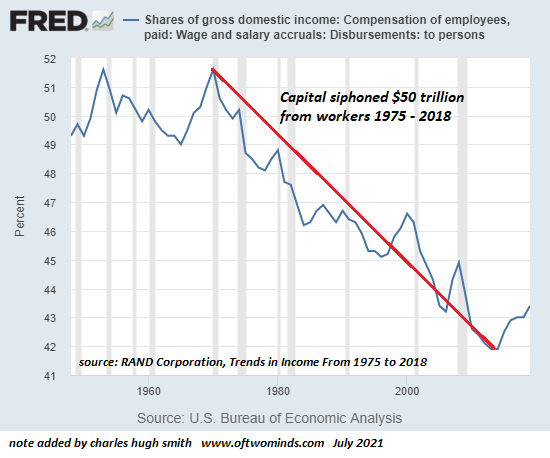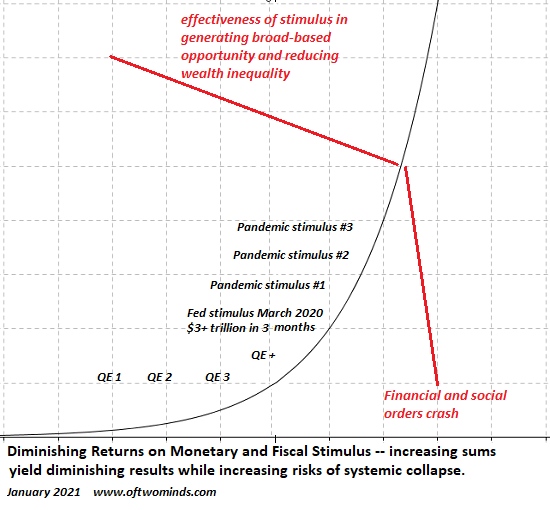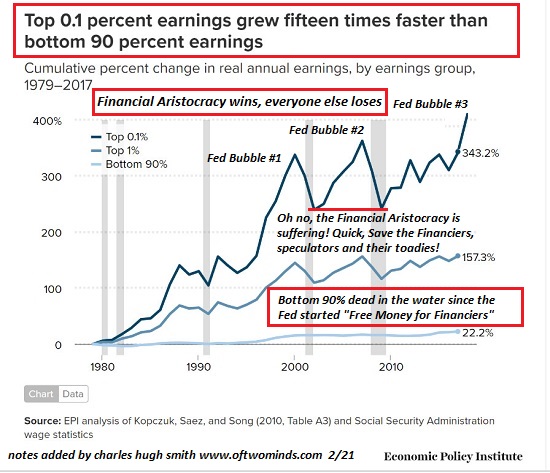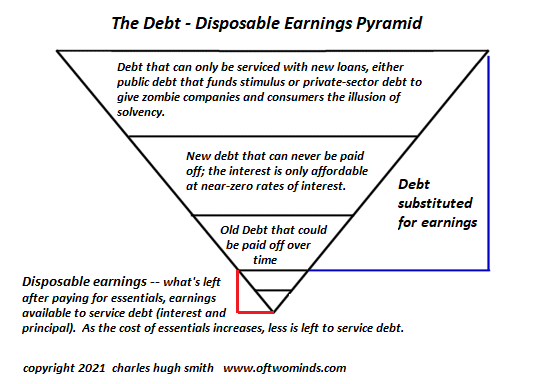Generations of punters have learned the hard way that their unwary greed is the tool the ‘Smart Money’ uses to separate them from their cash and capital. The game is as old as the stock market: the Smart Money recognizes the top is in, and in order to sell all their shares, they need to recruit bagholders to buy their shares and hold them all the way down. Once the catastrophic losses have been taken by the bagholders, then the Smart Money slowly builds up positions amidst the wreckage. It’s easy to become a bagholder; all you need is greed. Been there, done that, for the siren songs luring bagholders to their ruin are compelling and numerous. The Smart Money doesn’t have to mislead anyone; all they do is let the strident super-Bulls talk up the riches to be had
Topics:
Charles Hugh Smith considers the following as important: 5) Global Macro, 5.) Charles Hugh Smith, Featured, newsletter
This could be interesting, too:
RIA Team writes The Importance of Emergency Funds in Retirement Planning
Nachrichten Ticker - www.finanzen.ch writes Gesetzesvorschlag in Arizona: Wird Bitcoin bald zur Staatsreserve?
Nachrichten Ticker - www.finanzen.ch writes So bewegen sich Bitcoin & Co. heute
Nachrichten Ticker - www.finanzen.ch writes Aktueller Marktbericht zu Bitcoin & Co.
 Generations of punters have learned the hard way that their unwary greed is the tool the ‘Smart Money’ uses to separate them from their cash and capital. The game is as old as the stock market: the Smart Money recognizes the top is in, and in order to sell all their shares, they need to recruit bagholders to buy their shares and hold them all the way down. Once the catastrophic losses have been taken by the bagholders, then the Smart Money slowly builds up positions amidst the wreckage.
Generations of punters have learned the hard way that their unwary greed is the tool the ‘Smart Money’ uses to separate them from their cash and capital. The game is as old as the stock market: the Smart Money recognizes the top is in, and in order to sell all their shares, they need to recruit bagholders to buy their shares and hold them all the way down. Once the catastrophic losses have been taken by the bagholders, then the Smart Money slowly builds up positions amidst the wreckage.
It’s easy to become a bagholder; all you need is greed. Been there, done that, for the siren songs luring bagholders to their ruin are compelling and numerous. The Smart Money doesn’t have to mislead anyone; all they do is let the strident super-Bulls talk up the riches to be had by all those who buy today and hold indefinitely, and human greed does the rest.
Siren songs to lure the unwary greedy include these classics:
1. The Fed has our back, i.e. the Fed will never let stocks go down, so there’s no risk in buying more shares today.
2. Innovation stocks can only go higher as they create new industries that are the future of the economy.
3. Institutional buyers are coming in, and that means prices can only go higher.
4. This is a new era, old measures of valuation no longer matter.
5. Over time, stocks only go higher, so buy and hold is the winning strategy.
The greatest ally of the Smart Money is buy the dip, as the bagholders trained to buy the dip will continue buying every dip on the way down until their capital is expended. Bagholders see every rally off a dip as proof buy the dip works, when every rally off a dip has been engineered to suck in bagholders.
Every rally is another opportunity to sell for the Smart Money. The greatest hindrance to the Smart Money selling is low volume. The main point of selling is to dribble out shares in such modest doses that the price doesn’t move. If a big block of shares is dumped all at once, then the price collapses in low-volume markets. So the Smart Money sells slowly and methodically, transferring 100 million shares over time to a million bagholders who each buy 100 shares.
When questioned, the Smart Money prevaricates with generalities rather than show their hands. The market is “constructive” and “supportive of equities,” etc., meaningless terms intended to mask their steady selling and lull the bagholders into a false confidence in the Fed, innovation leaders, buy the dip, this time it’s different, etc.
The Smart Money can count on one thing: greed is sticky. Once a bagholder has decided that Innovation-XYZ is their one-way ticket to unearned wealth–just look at all the newly minted millionaires who did nothing but trade call options in Innovation-XYZ–then the Smart Money knows the bagholder will never let go of that belief until there’s no more money to throw into call options.
Generations of punters have learned the hard way that their unwary greed is the tool the Smart Money uses to separate them from their cash and capital. The tricks outlined in Reminiscences of a Stock Operator may have changed over time, but the game of selling at the top while stretching out the top to enable massive selling without moving markets is very much alive and well.
Tags: Featured,newsletter








